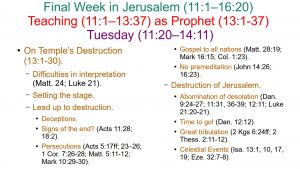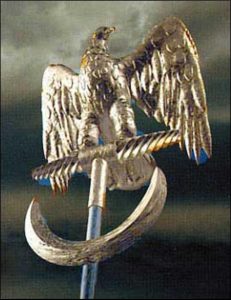Jesus’ Final Week in Jerusalem
Mark 11:1–16:20
Teaching (11:1–13:37)
King (11:1-11)
Sunday: Triumphal Entry (11:1-11).
Lawgiver (11:12–12:44)
Monday (11:12-19).
Tuesday (11:20–14:11).
Lesson from Fig Tree (11:20-26).
Jesus’ Authority Questioned (11:27-33).
Parable of Wicked Vinedressers (12:1-12).
On Taxes (12:13-17).
On Resurrection (12:18-27).
The Greatest Commandment (12:28-34).
An Unanswerable Question (12:35-37).
Warning About the Scribes (12:38-40).
Widow’s mites (12:41-44).
Prophet (13:1-37)
On Temple’s Destruction (13:1-30).
Difficulties in interpretation.
Setting the stage (13:1-4).
Leading up to the destruction (13:5-13).
 Jerusalem’s destruction (13:14-23).
Jerusalem’s destruction (13:14-23).Abomination of desolation (13:14).
Jesus then brings into the discussion the “abomination of desolation spoken of by Daniel the prophet.”
We find this mentioned in three places in Daniel (9:27; 11:31; 12:11).
Daniel 11 is a prophecy about the period after Alexander the Great, when the Greek Empire he founded split apart after his death into four smaller kingdoms.
The two that surrounded Palestine were the Seleucids in the north and the Ptolemies in the south.
They continually fought each other and the Jews were often caught up in the middle of it all.
They were in a very strategic location, so the land was frequently fought over by the giant empires to the north and to the south.
At some point, Antiochus IV Epiphanes of the Seleucids, a king who was a bit mad with power and after coming home from a humiliating loss against the Ptolemies, wrought devastation in Jerusalem.
He even outlawed Jewish religious customs, demanded that Zeus be worshiped in the temple, and had a pig sacrificed on the altar—an abomination of desolation!
This occurred on Dec. 6, 167 BC, and we can read about this in the Apocrypha (1 Macc. 1:54; 2 Macc. 6:1-11).
 In fact, the Jews called the Greek god Zeus a “desolating abomination.”
In fact, the Jews called the Greek god Zeus a “desolating abomination.”So the question becomes, if this occurred in the past, why is Jesus talking as if this is yet to come? Were they wrong to interpret Daniel’s prophecy as happening in 167 BC?
They did not misinterpret the one in Dan. 11, but recall, there are two other mentions of it in Daniel (9:27; 12:11).
In all three, sacrifices will be taken away, but there are certain time elements added to the ones in Dan. 9:27 & 12:11.
In Dan. 9:24-27 we have the 70 Weeks Prophecy which starts off talking about the Messiah who came and who died on the cross—He was “cut off, but not for Himself” (9:26).
It’s typically understood that the word here translated as “week” is not meant to be understood as seven days, but seven years. So 70 weeks represents 490 years (Dan. 9:24).
The covenant would be confirmed with many for one week, a period of seven years. In the middle (3.5 years), He puts an end to sacrifice and offering by giving Himself.
There is a space between that and the remaining 3.5 years of this week that culminates in the destruction of the temple in AD 70.
3.5 years prior, in late AD 66, something happens that starts this chain of events—Roman soldiers surrounding Jerusalem.
This time frame also reflects Dan. 12:11 and the 1290 days (~3.5 years) he gives from the abomination of desolation to the destruction.
To confirm this, let us consider what one of the other accounts of the Discourse says, particularly Luke’s. Matthew words his account similarly to Mark, but Luke says something else.
Before we read it, let’s read Mark’s account of it one more time so we can see the parallels and the differences (13:14; Luke 21:20-21).
Just prior to fleeing into the mountains, Mark’s account says they were to see the abomination of desolation. Luke’s states this flight should occur right after they see Jerusalem surrounded by armies, making no mention of an abomination—yet we see desolation.
Why would they need to be told this? If a city is surrounded by armies about to be besieged and you can escape, common sense says to escape, doesn’t it? But that’s not exactly how that happened.
The truth is that general Cestius, who began the siege in late AD 66, was recalled after the Jews in Jerusalem were about to surrender.
Because of this reprieve, the Jews saw this as a sign from God that He would bring them the victory should they come again.
The Jews often had a conceited notion that God would protect them no matter what.
The Christians, remembering Jesus’ warning, took this opportunity to get out while they could!
This calls to mind the people of Jeremiah’s day who thought God wouldn’t let them be taken into captivity, and if so then just for a couple years.
Many resisted, including King Zedekiah, and were killed, despite Jeremiah’s pleadings that they go along with Babylonian rule and live.
The Jews of the first century were no different—Jesus was telling His followers as Jeremiah told the Jews of his time, if you resist you will be killed. Submit (in Jeremiah’s case) or flee (in Jesus’).
The desolation these armies would bring would be far more devastating than anything Antiochus IV Epiphanes threw at them over 200 years before.
The city sacked, the temple destroyed by Titus under orders from Emperor Vespasian to end the conflict.
 We see how this brings desolation, but what part of this is an abomination?
We see how this brings desolation, but what part of this is an abomination?Well, Dan. 9:27 tells us that it is the “abominations [that] shall be one who makes desolate.” So whatever it is that brings the desolation is also the abomination.
These pagan idolaters were surrounding the city with their idolatrous symbols carried about with them, what are called ensigns.
They were in the shape of eagles and aligned with the Roman god Jupiter and symbolized the Roman Empire and her armies.
Jupiter, of course, is the Roman equivalent to Zeus whom the Jews called the “desolating abomination” in the 2nd century BC.
This actually fits with the latter part of Dan. 11 when the prophecy shifts to discuss the Roman Empire where “he shall honor a god of fortresses” (Dan. 11:36-39).
So when they see this happening, it’s time to go!
Time to go! (13:15-18).
There is a sense of great urgency that Jesus brings here.
Don’t wait, don’t hesitate, let’s go!
Most ancient houses back then had a flat roof with steps on the outside of it, so if one is on the roof for whatever reason, he could easily leave his home without having to go down inside it.
He may have had a good vantage point, seeing the Roman armies surrounding Jerusalem, too.
This is the same for those in the field—it would be easy to spot the Roman armies approaching and know that it’s time to go.
It would be especially hard on pregnant and nursing women, as I’m sure many of you know how difficult it is for such women to move around with their unborn or newborn babies.
Of course a winter flight would make it even more difficult to move due to the cold.
Cestius came through in November of AD 66 which could lead into winter, but thankfully they had 1290 days before they really had to leave.
Titus would return, however, in July AD 70 to begin the siege which lasted until September 3rd of that year, about 45 days—as Daniel said, it lasted from 1290 days to 1335, 45 days, about 1.5 months (Dan. 12:12).
This tribulation would be quite difficult.


